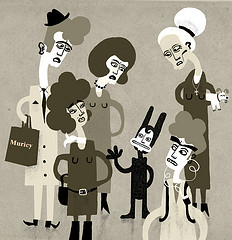[Note from Gene: It is very easy for those of use take care of other to choose to not take care of our selves. In this article Jondi Whitis offers some insight in how we can approach taking care of ourselves as we care for others.]
 photo by Rob Ireton |
All of us are caregivers at one time or another, and as energy practitioners, we're certainly caregivers, but what happens to those among us who choose this as a full-time vocation? Or those among us suddenly thrust into this role as a long-term situation?
Caregiving is challenging and spiritual work, in my book. It's intensity and duration make it particularly grueling in some cases, and it's critically important to get your batteries “put in correctly”, as Gary Craig would say, as well as to keep those batteries charged!
I don't know about you, but I am clear about this part of my capabilities. I see it like I see an athlete's:
I am a Sprinter. Not a Marathoner. I have gifts and passion for the instant bolt and the intense, deep, bursts of effort that a Sprinter would use to run and win the dash. But the skillset that a Marathoner owns feels daunting to me. The very long, drawn-out, frequently intense, day-to-day efforts that a full-time caregiver faces make these people heroic in my eyes.
Do you know some of each type? Good. Recognizing our strengths, and those of others, allows us to connect with one another, making each party stronger still. It sets up a natural teaching environment whereby we learn from one another, and celebrate each new skill on this journey we travel together. Supporting one another in this way not only keeps our tools sharp, but our hearts open, our egos in check, and eyes wide open to the mystery and wonder of healing, within us and all around us.
Why not give yourself a little gift today? Give yourself the gift of insight.
First, look at yourself with a loving eye and ask: which kind of runner ARE you? (And let that be marvelous, no matter what the answer.)
Second, truly see another you admire and give thanks for their gifts. Contact them, tell them what you admire about them, then share an insight or observation that's worked really well for you. Open yourself, your ears and heart to receive their insights, in return.
Third, linked by your Intentions to help and heal others as well as yourselves, tap a little for yourself.
Note: Enter into this tapping session with gladness, that you can give of yourself to some who gives wholly of themselves each day to another. Set your Intention together to restore, strengthen and find new springs or energy, resourcefulness, peacefulness and compassion within.
KC: Even though I am weary and I there is no end to this in sight, I want to accept myself.
KC: Even though I am so tired, and don't know if I can continue this way, I really do want to accept myself, and I'm doing the best that I can.
KC: Even though I don't know how much more of this I can take, I accept that this is how I really feel, and some days that has to be enough. I want to accept myself even on days like this.
TH: I'm exhausted.
EB: Really exhausted.
SE: It never lets up. It's overwhelming.
UE: What if it never lets up? It's never-ending.
UN: I'm so tired, so….I don't know how to keep going when I feel this way.
CH: What if I can't? Then what?
CB: It's terrifying to think I can't go on, but it's also terrifying to think what if I CAN? Just because I CAN, does that mean I have to? And for how long?
UA: Is there any good end to this?
UN: I can't think of one right now. I'm not feeling very resourceful. Just alone. Just exhausted.
WR: Too tired! Can't think, can only do – and barely that! Alone and exhausted.
KC: Too tired, too exhausted, hard to keep this up. Don't even know if I want to!
KC: Even though I find it hard to keep going; is there any good end to this? I do accept myself. Most of the time, anyway.
KC: Even though I am worried; what if I can't continue on this way? What if I have to? I really do want to accept myself, and this is the best I can do right now. I'm pretty sure that's the truth.
KC: Even though I feel that if I ask for help or tell anyone how I'm feeling they'll think I'm a bad person, I accept this is how I really feel. Don't I get to feel like being helped, too? I accept myself and this feeling.
TH: I don't know if I can go on this way, so tired and feeling guilty.
EB: Exhausted and guilty. Really? Hmm, maybe not guilty, maybe just….alone and unhappy.
SE: This tiredness that makes my brain hurt, that makes me feel burnt-out. And why'd I ever think I'd be good at this? Did I really have a choice? It's hard to tell anymore.
UE: What about ME? Did I just say that?! What if that is actually okay?
UN: Maybe it's not my fault.
CH: Maybe it's not their fault, either. Maybe it's no one's fault. I'm just exhausted, that's all.
CB: Maybe I could just use a little break. Maybe I could use a little ‘care', too.
UA: Is it possible I could get help, too? That it's okay to ask? Who would I ask, anyway?
UN: I can't ask for that – I'M the caregiver – I'M the one who…..the one who what?
WR: Maybe I could ask. Maybe someone would help. I don't know. I'm willing to consider it, anyway.
KC: Even caregivers need care, I guess. How would that feel? Could I let that feel good?
KC: Even though I find it hard to ask for help, I accept myself. I really do.
KC: Even though I'm supposed to be the caregiver, maybe I need care, too. And I really do want to feel better, like my old self. Maybe this is the best I can do right now, though. Maybe I really do accept me.
KC: Even if I ask for help or tell anyone how I'm feeling and they won't listen, could that be okay just to try it? I accept that I feel nervous about saying this out loud, about asking for help.
TH: Maybe I'm not a bad person, to ask for help. Maybe it doesn't make me weak or look bad to ask for help.
EB: Maybe I could reach out. Maybe no one actually knows what a toll this is taking on me.
SE: What if they reject me? What if they say, “No.” Is there anyone else I could talk to?
UE: Maybe I need to say it to someone new. Maybe there's help out there for me I didn't know about.
UN: I don't know what I'm doing anymore, but I'm willing to admit I need some help here.
CH: I don't even know where to begin. I'm nervous about asking for help and being rejected.
CB: I'm nervous either way. What if they say “Okay.” What if they don't?
UA: Either way, I might feel better, just saying it out loud.
UN: Maybe I could say it out loud and feel better.
WR: I really do want to feel better. I already do feel a little better. Hmmm.
KC: Maybe I will reach out. Who knows what could happen? Maybe something good. What's the worst that could happen? I've heard the word “No” before. I can take it. But what if it's a “Yes.” What if I could have help? What if I could get a break, and feel better?
| You can reach Jondi at EFTbrooklyn.com, or hear her interviews with EFT experts on EFT Radio On-Line on BlogTalkRadio; she specializes in helping others help themselves with the loving power of EFT, humor, warmth and forgiveness. |
















